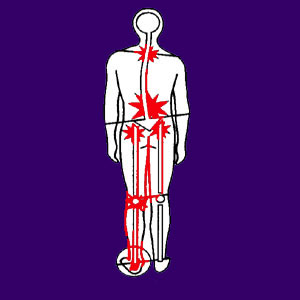
Pronated foot back pain is blamed on flat-footed conditions that influence the form and function of the anatomy from the ground up. Foot pronation has become another relatively common explanation for otherwise idiopathic back pain, as well as a popular revisionary diagnosis after treatment for previously diagnosed conditions has failed. Pronated foot-related back pain is certainly a controversial theory of causation, as we shall explore during the source of this dialog.
This guide explores the idea that back pain might be directly caused or contributed to by over-pronation of one or both feet. We will also provide counterpoint discussion on why many care providers doubt the validity of this theory and offer evidence to support both positions.
What is Pronated Foot Back Pain?
Foot over-pronation is defined as a condition typically associated with flat feet, wherein the person tends to bear their weight on the metatarsals of the second and third toes, rather than the first large toe. The inner ball of the foot tends to roll inwards, causing the weight to center on the mid foot, rather than the inner aspect of the ball of the foot, as is naturally designed.
Foot pronation can be visualized by a trained observer and usually presents a tell-tale abnormality wherein the heel bone will be located more towards the outside of the body than the ankle bone, instead of in a straight line, as is usual with normal foot positioning. Long-term presentation of the condition can flatten the arch of the foot, if it is not already flat. In essence, flat feet cause pronation and functional pronation can cause and exacerbate flat feet.
Many doctors embrace the idea that pronated foot back pain begins from the ground up, rather than from the spine down. This is in sharp contrast to the opposing theory embraced by NUCCA chiropractors, saying that virtually all health issues stem from abnormalities that begin at the frontier of the skull and the spine, due to Atlas subluxations. Since pronation of the feet will indeed influence the form and function of many bodily structures to some degree, it is certainly possible that flat feet might be the direct source of pain in some patients, as well as a contributing factor in others.
Pronated Foot Back Pain Causes and Contributors
Foot over-pronation will affect posture, gait and anatomical alignment. These are scientifically-proven facts. Flat footedness and over-pronation can contribute to, or directly cause, back pain through the following mechanisms, all of which have been observed by medical practitioners in select patients:
Pronated feet will change the form and function of the joints in the legs, such as the ankle, knee and hip. These changes can influence how weight is supported and might create anatomical imbalances and strain on the spine, sacroiliac joint or postural muscles.
Pronated feet will also directly influence the symmetry and balance of the spine, spinal joints, sacroiliac joint and postural muscles.
Severely pronated feet might place inordinate pressure on a narrowed spinal canal or narrowed foraminal spaces, possibly exacerbating existing neurological compression conditions.
Pronated feet might influence the degree of lumbar lordosis expressed.
Common symptoms of pronated foot back pain might include focal or widespread muscular symptoms, piriformis syndrome and other types of sciatica or pseudo-sciatica. Symptoms can be present in the feet, legs, buttocks, lower back, middle back, upper back or even neck in rare circumstances.
Pronated Foot Back Pain Critics
Not all doctors support the idea that pronation of the feet causes any problems whatsoever. In much the same way as evidence has been cited to support the theory of pronated foot back pain, much evidence has also been gathered, processed and proven to support the opposite point of view that flat feet are usually complete nonissues when it comes to health.
Doctors report that the body is wonderful in its ability to compensate for imbalances, as well as structural and functional abnormalities. The anatomy is homeostatic and able to correct itself and adapt form and function to suit virtually all irregularities. There is no doubt that most people with flat feet do not develop back pain from foot pronation due to these reasons.
In this regard, pronated feet can act just like any other back pain scapegoat. Sure, abnormality of structure might be present, but it is not pathological and judged to be a nonissue in causing any back symptomology which may be present. This is very similar to leg length differentials or any of the numerous spinal abnormalities that are often blamed unfairly for causing back pain.
As a final note, remember that some cases of foot pronation back pain might exist due to pure nocebo effect and the conditioning process alone. In essence, these are psychological pain syndromes that were given credibility for a structural cause of pain when the pronation issue was diagnosed. Dr. John Sarno became famous for discussing how these nocebo-related pain conditions could persevere for decades, even though they had no true structural basis at all, using ischemia as the direct mechanism of pain, even though the flat feet took the blame.





